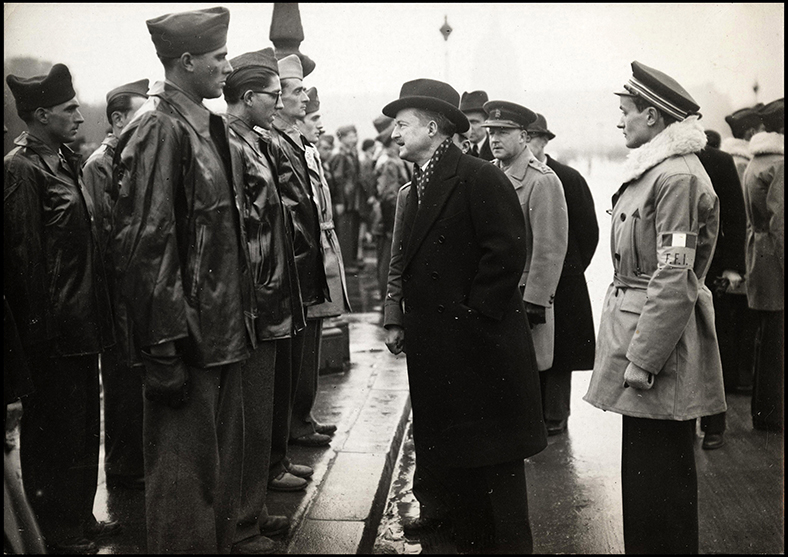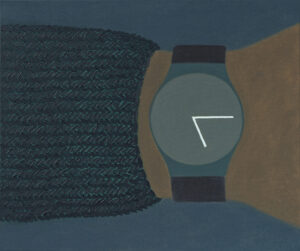
Broken Water Cooler, by Fintan Magee
© The artist. Courtesy KIRK Gallery, Aalborg, Denmark
New Books
Carrie Sun used to be on the side of Big Money. Her memoir, Private Equity (Penguin Press, $29), describes her disillusioning tenure as an assistant to Boone Prescott, the founder of a hedge fund called Carbon. (These are both pseudonyms, and good ones; Boone’s name is so slick with patrician unctuousness that it wants to be whispered more than spoken.) At first, reading Sun’s dedication—for “all those who have the courage to quit”—I thought she might be a fox in the most deluxe of henhouses: a closet socialist who’d gaslight her boss into submission, fit him with a shock collar, and dissolve his fortune.
But a true radical would never get on a first-name basis with a man like Boone. When Sun, at twenty-nine, took the job about a decade ago, she “believed in the possibility of good billionaires,” and didn’t have “a ton of sympathy for poor people.” At one of her fourteen interviews for the assistant role, she says, “My favorite class in college was optimization. I’d love to optimize someone’s life and help someone great do great things.” In her sheath dress and Louboutins, she’s fluent in the idiom of finance, where one doesn’t introduce people but “intros” them, doesn’t make a change but “do[es] a pivot,” cares not about the fine arts but the “fine arts space.” She doesn’t simply meet with Boone; she’s “in a sit” with him, a ritual in which she ministers to his every whim, including, say, his diet: “Protein—not heavy. Salad/soup. Clean. Not spicy, salty. . . . Anti-cancer.” (Presented with a Chipotle burrito bowl, he recoils: “What is this?”) “How are you with positive feedback?” he asks. “Because I don’t give it.” Objecting to her “energy,” he says, “I need you to walk with more confidence and just come in, and then get out, but also be more easygoing, relaxed, and chill.”
Still, Sun claims without irony that she loved her job—Carbon is a proudly irony-free workplace. The employee handbook stipulates that “Individuals should refrain from using vulgarities, obscenities, jokes, sarcasm,” which means Boone isn’t kidding when he describes his grossly profitable firm as having a “give-first culture.” Its largesse includes an on-site fitness center with complimentary Lululemon apparel and Restoration Hardware towels “as thick as blankets”; a thousand-dollar cake thrown away uneaten; an entire amusement park rented out for the use of a few children on Family Day. The company has official Pantone colors. Its bathrooms are opulent (marble sinks) but unisex, like the one in Ally McBeal. Even with auto-flushing toilets, the office hires a full-time staffer to clean each toilet after every use. In place of water-cooler talk are exchanges like this one:
“Can I get you anything to drink?” Charlotte asked. “We have water, coffee, tea, soda . . . ”
“Water, please.”
“Sparkling or still?”
“Sparkling.”
“Ice or no ice?”
“Ice.”
As for actual philanthropy, it’s an afterthought. At a presentation about the company’s values and long-term goals, Sun notices that the final section, on “Distinctive Impact in Community,” says only “TBD.” Here the scales begin to fall from her eyes. A Chinese-American immigrant, she has been berated by her parents, mocked by her classmates, assaulted at MIT, harassed at her last job, and controlled by her fiancé, who “found it sexy when [she] ate only lettuce.” Her father believes a person’s “family value” is “100 divided by # of persons being dated with the max value of 100.” Reading The Handmaid’s Tale in school, she was unmoved: “The main character’s life under a totalitarian regime was fine. She was alive.” All of this has shaped her into someone shapeless—an ideal underling for Boone, who, she says, “wanted me to reduce the aperture of my consciousness.” She shrinks it well past the vanishing point: The diary she keeps for her “inmost thoughts” contains only one entry. At the company gym, she falls off the treadmill while trying to answer an email on her phone, and after binging on cookies, she sticks her fingers down her throat “to rid myself of myself.” Boone encourages her to prolong a juice cleanse and notes the limpness of her new boyfriend’s handshake.
Having promised the boss five to ten good years, she quits after two. And that’s it, really. Private Equity is emphatically not polemical. In its 352 pages, inequality comes up about a quarter of the way through and passingly thereafter. Marx gets a nod in the final chapter. Its primer on investment banking is lucid, but what Sun knows best are the caprices of the overclass, the “banality of genius” as it’s said to exist among CEOs, and the forcible act of self-discovery that results from low morale and exorbitant pay. (Regrettably, for all her candor, she never says how much she made.) Her awakening feels hard-won, and she captures the hollow cultishness that crept over white-collar New York in the Obama years, when Gordon Gekko types started going to SoulCycle. Indeed, the same qualities that nearly reduced her to an automaton have made her an astute, punctilious narrator. Her billionaire boss, hugging her goodbye, gets off easy—but they always do. Apparently he’s almost never interviewed or photographed. A coup, then, that in these pages he’s fully, suboptimally human.

Duff Cooper, the British ambassador to France, meets a group of French resistance fighters, November 1944 © Léonard de Selva/Bridgeman Images
“I don’t see you as a writer,” Boone tells Sun. “You’re too much of a doer.” The same might have been said of Duff Cooper, a British viscount, diplomat, politician, war hero, man-about-town—always good for a glass of port or an extramarital romp. Ever the hedonist, he died on a cruise ship in 1954. “Had he made himself the subject of his first novel,” wrote one critic of Cooper’s Operation Heartbreak (McNally Editions, $18), “a much more interesting book would have resulted.”
But Operation Heartbreak is interesting precisely because its hero shares none of his author’s suavity. Published in 1950, it tells the story of Willie Maryngton, an aggressively bland cavalry officer with no family and few true friends, for whom to go into battle is “the summit of human desire”: “He had seen somewhere a book called The War to End War. The title had sent a shiver of horror down his spine.” Alas, Willie was born too late to join the First World War and too early to enter the Second—and between the two, the forces of mechanization replaced his beloved horses with tanks. Among his fellow officers, he commands camaraderie but never authority.
Well, a life of quiet desperation it is, then. On a tour of India, Willie falls sheepishly, gawkily in love with a colonel’s daughter, but after a long drink of him—“so simple and so good . . . it would be rather a shame to marry him”—she elopes with a strapping Irishman instead. In retrospect, “he understood there had been something missing. They danced together, and rode together, and talked about dances and horses.” His next romance, back in London, is with his foster sister, whose hot-and-cold spells sustain and frustrate him for years. All he can do is nurse his cynicism while teaching tomorrow’s soldiers, “grooming a lot of silly boys until we think they’re fit to be sent out and get killed.” The Germans bomb his building into oblivion. Those around him notice his fountain of kindness running dry.
Operation Heartbreak is barely longer than a novella, but it accommodates a leisurely, wending fatalism that reminds me of Thomas Hardy, especially when Cooper issues one of his weary narrative sighs: “But, because men can never be quite happy for long . . . ”; “Like all historical facts, these were curiously hard to establish . . . ” As Willie’s despair hardens him, his foster brother waxes philosophical. “A moment comes when something happens like the mainspring of a watch breaking,” he says. “The façade remains the same, perhaps for a long time, and most people can see no difference.” It’s the same story as Sun’s, repression and oppression in lockstep—the quiet churn of human capital in massive institutions, people used up by marching in place.

5:15, 2021, oil on canvas, by Henni Alftan. Courtesy the artist, Karma, and Sprüth Magers
It takes skill to hang so much loneliness on such a slight frame, but Cooper’s real trick is his ending, which nearly got the novel suppressed in England. Willie dies: of inertia or, if you prefer, its primary symptom, heartbreak. His corpse is enlisted by the secret service to join the war he never saw in life. They deposit some phony documents on his person and arrange for him to wash up on the shores of another nation. Foreign agents spread his false information as fact, and the enemy is led deliciously astray.
This brazen bit of spycraft had really happened, in 1943—Operation Mincemeat, as it was known, was dreamed up in part by Ian Fleming—and it was still under wraps when Cooper put it in his plot. As wry as he is, you can still hear the Union Jack flapping in the background of his rendition (“the Lieutenant stood to attention and saluted as they laid the body of the officer in uniform as gently as possible on the face of the waters”), and the glory was lost on me. I felt a bit like Sun shrugging at The Handmaid’s Tale because its heroine, for all her sorrows, was still alive. So Willie got to serve his country! He was still dead.
The utility of corpses—their ability to speak or stay quiet long after their flesh has sloughed off—is the subject of the former FBI forensic artist Lisa Bailey’s memoir, Clay and Bones (Chicago Review Press, $28.99). It begins with a trip to the Body Farm, an open-air cadaver collection in Knoxville, Tennessee, where scientists deposit unclaimed or donated bodies as part of a longitudinal study on human decomposition. (There are many stations on the road to skeletonhood.) Standing among the flies and maggots, Bailey aspires to compile a database of skulls and the faces they once had, a set of standards against which to check her work. Her job with the FBI entails sculpting “facial approximations” based on long-forgotten remains, a feat of reverse engineering that might, in a less enlightened time, qualify as satanic: reconstructing a life from the fragments of death. Today it’s just another government budget line. The hope is that her faces will trigger a flicker of recognition in the general public, and wham—another cold case cracked. For this she receives a modest salary, a security clearance, and an office in Quantico, from which she could “watch the deer munching on the lawn in front of the laboratory while helicopters filled with marines in tactical gear flew overhead.”
To excel as a forensic artist would seem to require a painter’s sensitivity toward our malleable features—how minutely they inscribe our exposure to stress, time, love, weather, loss. But Bailey doesn’t regard herself as an artist, and her work, as she describes it, has none of the romance of necromancy. Her book passes without so much as a poor Yorick joke, indeed, without a single use of visage. She’s more the kind to exclaim, “Holy cow, look at this occipital ridge!” And this makes her very good at what she does. If Clay and Bones sometimes has the tone of a PG-rated Halloween movie, it’s only because she has a job to do. “I could look at severed heads while eating a cranberry muffin and not think twice about it,” she brags.

A scanning electron micrograph of maggots
© Dr. Jeremy Burgess/Science Source
She started at the agency in November 2001. Formerly a graphic artist, she was thrust into a setting where skulls were kept in a “nondescript gray locker”: “This was awesome!” One of her first assignments was to help retouch and digitize thousands of images of 9/11 victims, known internally by the bloodless code name PENTTBOM. Many FBI rules were unwritten, she soon learned—it was best, for instance, not to make her courtroom presentations “too good.” She explains, “The worry was that it would seem like the defendant didn’t have a chance against the deep pockets and never-ending resources of the government.” Within a year, she’d cradled a skull rumored to belong to one Osama bin Laden (it turned out to be some other guy) and visited the site of a plane crash where she saw a man’s head without skin, his necktie still taut around his collar. She interviewed witnesses to make composite sketches and honed her knowledge of facial anatomy, delighted when her drawings solved otherwise intractable crimes. Her husband would catch her staring clinically at his physiognomy.
The honeymoon ended when her supervisors—nearly all men, of course—revealed themselves to be incompetent, cruel, or both. Their hectoring became inescapable. “Nope, you’re not making any sense at all!” one of them told her in a meeting. “You just keep on babbling! . . . Blip, bloop, bloop, bloop! I don’t know! I don’t know! Hahahahaha! Bloop, bloop, bloop! This is you!” Another, she discovered, had been reprimanded by a federal judge for the “multiple inadequacies” of his expert testimony; as he could no longer be trusted to appear at trial, the agency simply promoted him out of the job. Bailey filed a discrimination complaint, a costly, yearslong affair. As the FBI marshaled its legal forces against her, its publicists trotted her out for puff pieces promoting the bureau. She was “accused of insubordination, threatened with termination or the loss of my clearance,” and summarily interviewed by the Washington Post about the quirks of forensics.

Vanitas-Stillleben (Totenkopf auf einem Buch), 1869, by Wilhelm Trübner
© akg-images
Have you guessed the pattern? Here comes another loss of faith. Though a judge found the FBI narrowly guilty of discrimination, the ruling was lenient, and in 2019 Bailey was pushed into early retirement. She came to see the agency as “a finely tuned reprisal machine, set to autopilot,” and she now hates “the part of the FBI that not only allowed this to happen but encouraged it, threw gasoline on it, and then covered up the ashes.” I picture her in a quiet room, using clay and taxpayer-funded scraping tools to prise an identity from the clutches of the past as, all around her, one of the world’s most byzantine bureaucracies grinds her life’s meaning into dust: Operation Heartbreak.


